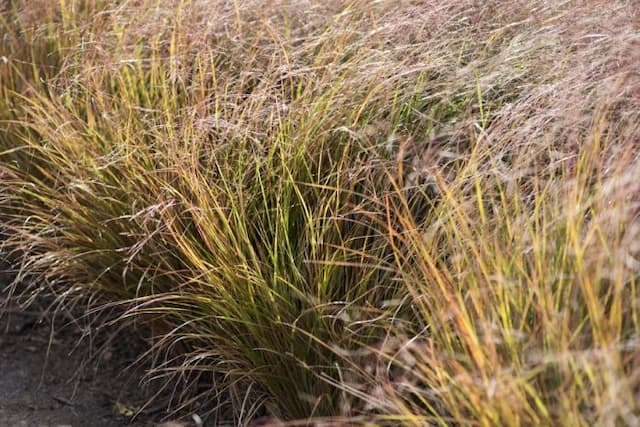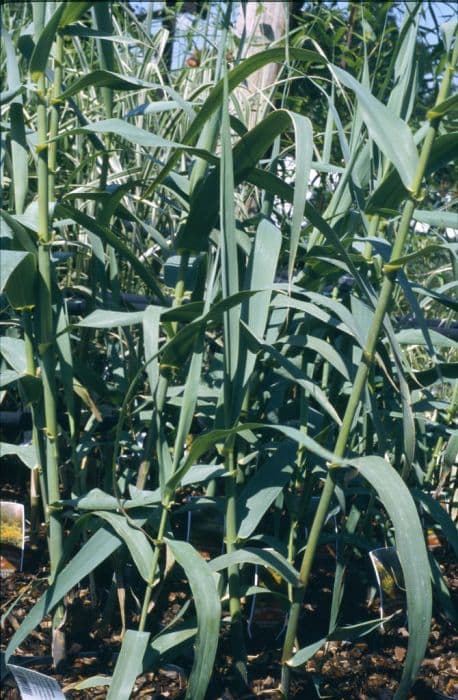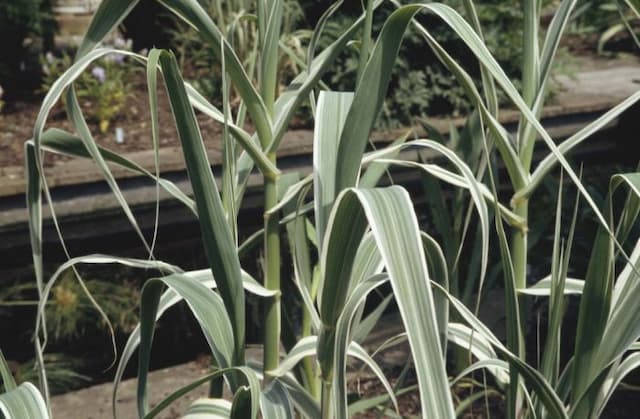Feather Grass Stipa capillata

ABOUT
Stipa capillata, commonly known as feather grass or needle grass, is a perennial grass known for its distinctive fluffy, feathery appearance. The leaves of the plant are fine and thread-like, creating a delicate texture that bends gracefully with the slightest breeze. These leaves often have a blue-green or grayish tint, adding to the soft aesthetic of the plant. The most striking feature of feather grass is its flower spikelets, which bear a resemblance to thin, elongated feathers. These flowering parts emerge on tall, slender stems that rise above the foliage. They are silvery or golden in color and catch the light in a way that can make the plant shimmer from a distance. The flowers have long, hair-like awns that extend from the main shaft, giving the bloom a light, airy, and ethereal quality. In its growth habit, feather grass forms dense clumps, with the foliage creating a tussock that serves as the base for the more visually dominant flowering stems. The plant overall has a gentle and flowing form, often used in landscape design to add texture, movement, and a natural wild grassland aesthetic.
About this plant
 Names
NamesFamily
Poaceae
Synonyms
Needle Grass, Hair Grass, Feather Grass, Eurasian Feathergrass, Bride's Feathers, Esparto Grass, Thyme-leaf Feather Grass
Common names
Anatherum capillatum, Aristida capillata, Lasiagrostis capillata, Stipa capillata subsp. capillata, Stipa capillatifolia.
 Toxicity
ToxicityTo humans
Stipa capillata, commonly known as feather grass, does not have a widespread reputation for being toxic to humans. There is limited information available regarding its toxicity, but it is not generally listed among plants known for being poisonous to people. If you suspect poisoning from any plant, it is vital to seek medical attention immediately.
To pets
Feather grass, also known as Stipa capillata, is not commonly recognized as a toxic plant to pets. However, it's important to note that the sharp seeds can potentially cause physical injury if ingested or if they come into contact with a pet's eyes or skin. If your pet shows signs of distress after ingesting plant material, consult with a veterinarian as a precaution.
 Characteristics
CharacteristicsLife cycle
Perennials
Foliage type
Deciduous
Color of leaves
Green
Flower color
Varies
Height
2 feet [60 cm]
Spread
1 feet [30 cm]
Plant type
Herb
Hardiness zones
4
Native area
Eurasia
Benefits
 General Benefits
General Benefits- Erosion Control: Stipa capillata's root system helps to stabilize soil and prevent erosion.
- Habitat Provision: It provides a habitat for wildlife, including a variety of insects and birds.
- Aesthetic Value: With its delicate feathery plumes, it contributes to the visual appeal of landscapes and gardens.
- Drought Tolerance: This plant is well-adapted to dry conditions, reducing the need for irrigation.
- Low Maintenance: Requires minimal care once established, making it suitable for low-maintenance landscaping.
- Grazing Resistance: Its tough foliage is not preferred by grazing animals, making it a durable choice in pastures or natural landscapes.
- Windbreak: Its presence can help reduce wind velocity at the ground level, protecting smaller plants and reducing soil drying.
 Medical Properties
Medical Properties Air-purifying Qualities
Air-purifying QualitiesThis plant is not specifically known for air purifying qualities.
 Other Uses
Other Uses- Ornamental grass: Stipa capillata, commonly known as feather grass, is often used in landscaping for its delicate, feathery plumes that can add texture and movement to garden designs.
- Erosion control: The deep root system of feather grass can help stabilize soil and prevent erosion on slopes or in areas prone to land degradation.
- Wildlife habitat: Feather grass provides shelter and nesting material for birds and can be a habitat for beneficial insects.
- Floral arrangements: The attractive seed heads of feather grass are used in dried flower arrangements and bouquet fillers.
- Craft material: The sturdy stems and distinct seed heads can be incorporated into crafts such as wreath making or decorative art pieces.
- Cover crop: In agricultural settings, feather grass might be used as a cover crop to protect and enrich the soil between plantings.
- Soil improvement: Feather grass can be used in phytoremediation to improve the structure and nutrient content of the soil over time.
- Windbreaks: Tall varieties of feather grass can be planted in rows to protect smaller plants from strong winds.
- Textile inspiration: The texture and form of feather grass can inspire designs in weaving, textiles, and fabric patterns.
- Education and research: Feather grass might be used in educational settings or research studies to demonstrate grassland ecology and plant biology.
Interesting Facts
 Feng Shui
Feng ShuiThe Feather Grass is not used in Feng Shui practice.
 Zodiac Sign Compitability
Zodiac Sign CompitabilityThe Feather Grass is not used in astrology practice.
 Plant Symbolism
Plant Symbolism- Resilience – Stipa capillata, often referred to as "Feather Grass", has a remarkable adaptability to various climate conditions, symbolizing the ability to withstand and adapt to the challenges of life.
- Grace – The feathery and delicate appearance of its flower heads wave gracefully in the wind, representing elegance and poise in the face of external forces.
- Freedom – Feather Grass seeds are carried easily by the wind, symbolizing an unrestrained and free spirit, as well as the concept of letting go and spreading new beginnings.
- Simplicity – The understated beauty of the Feather Grass emphasizes the value of simplicity and the idea that there is elegance in minimalism.
 Water
WaterFor Feather Grass, proper watering is essential, particularly during its growing season in spring and early summer. It should be watered deeply but infrequently, allowing the soil to dry out between waterings. Typically, this may equate to about 1 to 1.5 inches of water every couple of weeks, depending on climate conditions. The precise amount of water it needs can vary with temperature and rainfall, so monitoring the soil moisture is key. Water the plant at the base to avoid wetting the foliage, which can lead to fungal diseases, using approximately half a gallon for mature plants per watering session.
 Light
LightFeather Grass thrives in full sunlight, so the best spot for it would be an area where it can receive at least six hours of direct sunlight daily. Ensure that it is planted in a location in your garden that isn’t shaded by larger plants or structures. This grass does not grow well in partial shade, as it may become leggy and less vigorous in seeking light.
 Temperature
TemperatureFeather Grass prefers a temperate climate and can endure a wide range of temperatures. It can survive in temperatures as low as 0°F and as high as 80°F. For optimal growth, temperatures between 50°F to 75°F are ideal. It is a hardy plant that tolerates both cold and heat once established, but younger plants should be protected from extreme conditions.
 Pruning
PruningPruning Feather Grass isn't usually necessary for the health of the plant, but it can be done to maintain its appearance. Trimming back the foliage in the late winter or early spring before new growth starts is recommended. This helps to tidy the plant and encourages fresh, new growth. Pruning should be done moderately, cutting back no more than a third of the plant's height.
 Cleaning
CleaningNot needed
 Soil
SoilFeather grass prefers well-draining soil with a neutral to slightly alkaline pH, around 6.0 to 7.5. A mix of loam, sand, and compost is ideal to provide nutrients and proper drainage.
 Repotting
RepottingFeather grass is a perennial and typically does not require frequent repotting. Repot only if it outgrows its current container, which may be every 2-3 years.
 Humidity & Misting
Humidity & MistingFeather grass thrives in average humidity levels and does not require special humidity conditions. It is adaptable to the natural outdoor humidity.
 Suitable locations
Suitable locationsIndoor
Place feather grass in bright light, minimal watering.
Outdoor
Plant in full sun, well-drained soil, low maintenance.
Hardiness zone
4-9 USDA
 Life cycle
Life cycleStipa capillata, commonly known as feather grass, begins its life cycle as a seed, which germinates in the presence of adequate moisture and temperature conditions, typically in late winter or early spring. The seedling emerges, developing a root system and a small rosette of leaves close to the ground. As it matures, the grass grows taller and produces narrow, elongated leaves and stems. It reaches the reproductive stage in late spring to early summer, where it produces tall, slender flowering stalks tipped with feathery, hair-like structures known as awns. Pollination occurs through wind, after which the fertilized flowers develop into seeds that mature by late summer. These seeds are eventually shed to the ground, where they remain dormant until the next germination cycle, completing the life cycle of feather grass.
 Propogation
PropogationPropogation time
Spring-Early Summer
Stipa capillata, commonly referred to as feather grass, is typically propagated through seed. The most popular method involves collecting seeds in late summer or early autumn, as they mature on the plant. Seeds can be sown directly in the ground where they are to grow or started in containers. The soil should be well-draining, and the seeds lightly covered with soil. They usually germinate best at temperatures between 55 and 65 degrees Fahrenheit (13-18 degrees Celsius). After seedlings have developed a few true leaves and are sturdy enough, they can be transplanted outdoors to their permanent location, provided the risk of frost has passed. Feather grass thrives in full sun and prefers a drier, well-drained soil.









